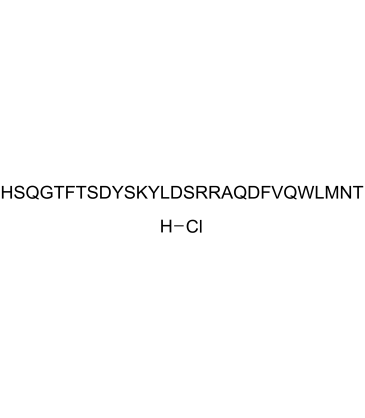28270-04-4
| Name | Glucagon hydrochloride |
|---|
| Description | Glucagon hydrochloride (Porcine glucagon hydrochloride) is a peptide hormone, produced by pancreatic α-cells. Glucagon hydrochloride stimulates gluconeogenesis[1]. Glucagon hydrochloride decreases the activity of HNF-4[2]. Glucagon hydrochloride increases HNF4α phosphorylation[3]. |
|---|---|
| Related Catalog | |
| In Vitro | Upon binding to its receptor Gcgr, Glucagon activates cAMP-PKA signaling to stimulate hepatic glucose production (HGP) and cause hyperglycemia[1]. Glucagon stimulates both hepatic kisspeptin1 production and gluconeogenesis[1]. Glucagon (100 nM) represses CYP7A1 mRNA expression in human primary hepatocytes[3]. Glucagon (100 nM) increases phosphorylayion of HNF4α[3]. Western Blot Analysis[3] Cell Line: Human primary hepatocytes (H1211, HH1215) Concentration: 100 nM Incubation Time: Result: Resulted in a marked increase in the amount of phosphorylated HNF4α. |
| In Vivo | Low-dose (20 μg/kg) Glucagon increases glycemia and does not stimulate insulin secretion in ambient-fed mice. High-dose (1 mg/kg) Glucagon lowers glycemia compared with PBS control and stimulates insulin secretion in ambient-fed mice[4]. Animal Model: C57BL/6J mice (12- to 24-week-old)[4] Dosage: 20 μg/kg and 1 mg/kg Administration: Administered by i.p. injection; 45 minutes Result: Low-dose (20 μg/kg) increased glycemia and did not stimulate insulin secretion. High-dose (1 mg/kg) lowered glycemia and stimulated insulin secretion. |
| References |
| Molecular Formula | C153H225N43O49S.ClH |
|---|---|
| Molecular Weight | 3519.21 |
